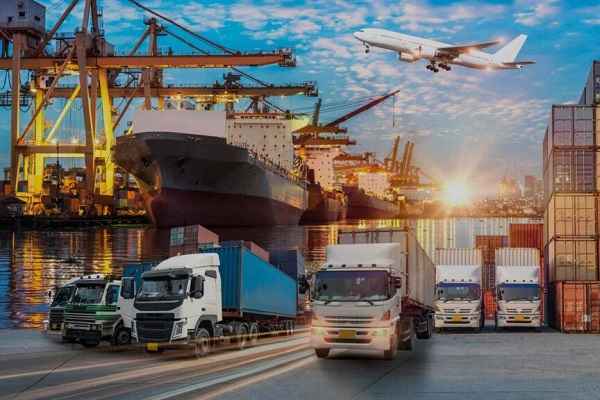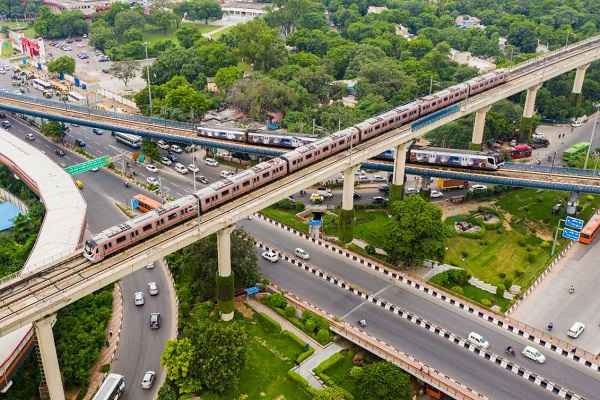 Delhi unveils ambitious Urban Mobility Vision: Luxury Metro Coaches, New Tunnels and Pod Taxi
Delhi unveils ambitious Urban Mobility Vision: Luxury Metro Coaches, New Tunnels and Pod Taxi Qatar approves Saudi Rail Link Agreement, Accelerating Gulf Railway Vision 2030
Qatar approves Saudi Rail Link Agreement, Accelerating Gulf Railway Vision 2030 UP Govt plans to introduce Water Metro services in Ayodhya, Varanasi & Prayagraj
UP Govt plans to introduce Water Metro services in Ayodhya, Varanasi & Prayagraj India’s First Urban Ropeway begins Trial Run in Varanasi, Set to carry 1 Lakh passengers daily
India’s First Urban Ropeway begins Trial Run in Varanasi, Set to carry 1 Lakh passengers daily India and Bhutan to Build First-Ever Rail Link: ₹4,033 Cr Project to Boost Regional Connectivity
India and Bhutan to Build First-Ever Rail Link: ₹4,033 Cr Project to Boost Regional Connectivity Patna to launch Eco-Friendly Water Metro; Trial Run soon between Digha and Kangan Ghats
Patna to launch Eco-Friendly Water Metro; Trial Run soon between Digha and Kangan Ghats Air India Group set to launch Flights Operations from Navi Mumbai International Airport
Air India Group set to launch Flights Operations from Navi Mumbai International Airport Chennai to launch 25-Year Mobility Plan with Unified QR Ticketing and One-App Transit System
Chennai to launch 25-Year Mobility Plan with Unified QR Ticketing and One-App Transit System Kochi Metro bags ₹4.4 crore contract to prepare DPR for Mumbai Water Metro Proejct
Kochi Metro bags ₹4.4 crore contract to prepare DPR for Mumbai Water Metro Proejct Navi Mumbai International Airport set for September launch; IndiGo and Akasa Air to lead Operations
Navi Mumbai International Airport set for September launch; IndiGo and Akasa Air to lead Operations
Govt of India launches National Logistics Policy, Know All About

New Delhi, India (Urban Transport News): To boost both Ease of Doing Business as well as Ease of Living and reduce the cost of logistics across the country, Prime Minister Narendra Modi launched the National Logistics Policy at Vigyan Bhawan, New Delhi today.
The Indian logistics sector provides livelihood to more than 22 million people and improving the sector will facilitate a 10 % decrease in indirect logistics costs leading to the growth of 5 to 8% in exports. Further, it is estimated that the worth of the Indian logistics market will be around USD 215 billion in the next two years compared to about USD 160 billion at present.
It has been the vision of the Prime Minister to develop world-class modern infrastructure through the integration of all stakeholders in holistic planning and implementation so that efficiency and synergy are achieved in the execution of the project. The PM GatiShakti – National Master Plan for muti-modal connectivity – launched by the Prime Minister last year, was a pioneering step in this direction. PM GatiShakti will get further boost and complementarity with the launch of the National Logistics Policy.
Need for a national logistics policy
- India’s logistics sector is highly defragmented and the aim is to reduce the logistics cost from the present 14% of GDP to less than 10% by 2022.
- As per the Economic Survey 2017-18, the Indian logistics sector provides livelihood to more than 22 million people and improving the sector will facilitate a 10 % decrease in indirect logistics costs leading to the growth of 5 to 8% in exports.
- Further, the Survey estimates that the worth of the Indian logistics market would be around USD 215 billion in the next two years compared to about USD 160 billion currently.
Key feature of the National Logistics Policy
- The National Logistics Policy has been prepared in consultation with the Ministries of Railways, Road Transport and Highways, Shipping and Civil Aviation. Forty-six Partnering Government Agencies (PGAs) inputs were analysed in detail for consideration in the Policy.
- Vision and Objectives for Logistics in India: To drive economic growth and trade competitiveness of the country through a truly integrated, seamless, efficient, reliable and cost-effective logistics network, leveraging best-in-class technology, processes and skilled manpower.
- Key objectives of the national logistics policy: Given the pivotal role of the logistics sector in the development of the economy and the need to incorporate learnings from global best practices, the policy outlines an ambitious set of objectives. The following are some of the key objectives for logistics in India, to be achieved in the next five years:
- Creating a single point of reference for all logistics and trade facilitation matters in the country which will also function as a knowledge and information sharing platform
- Driving logistics cost as a % of GDP down from estimated current levels of 13-14% to 10% in line with best-in-class global standards and incentivize the sector to become more efficient by promoting integrated development of logistics
Objectives of the National Logistics Policy
- Creating a National Logistics e-marketplace as a one-stop marketplace. It will involve simplification of documentation for exports/imports and drive transparency through digitization of processes involving Customs, PGAs etc in regulatory, certification and compliance services
- Creating a data and analytics center to drive transparency and continuous monitoring of key logistics metrics
- Encouraging industry, academia and government to come together to create a logistics Center of Excellence, and drive innovation in the logistics sector
- Creating and managing on an ongoing basis, an Integrated National Logistics Action Plan which will serve as a master plan for all logistics-related development.
- Providing an impetus to trade and hence economic growth by driving competitiveness in exports
- Doubling employment in the logistics sector by generating additional 10-15 million jobs and focusing on enhancing skills in the sector and encouraging gender diversity
- Improve India’s ranking in the Logistics Performance Index to between 25 to 30
- Strengthening the warehousing sector in India by improving the quality of storage infrastructure including specialized warehouses across the country
- Reducing losses due to agri-wastage to less than 5% through effective agri-logistics
- Providing impetus to the MSME sector in the country through a cost-effective logistics network
- Promoting cross-regional trade on e-commerce platforms by enabling a seamless flow of goods
- Encouraging the adoption of green logistics in the country
Policy thrust areas
This policy defines the key thrust areas for logistics in India, which will be the focus of the relevant ministries as well as act as a guide to the state governments. The prioritized focus areas for logistics are detailed below:
- Focusing on critical projects to drive an optimal modal mix and to enable first mile and last mile connectivity
- Driving the development of Multi Modal Logistics Parks (MMLPs)
- Driving interventions to reduce logistics costs and promote logistics efficiency for the movement of key commodities
- Creating a single window Logistics e-marketplace
- Setting up a Logistics Data and Analytics Center
- Creating a Center of Trade Facilitation and Logistics Excellence (CTFL) and leveraging the expertise of multilateral agencies
- Creating an Integrated National Logistics Action Plan and aligning with respective state development plans
- Support strengthening of the warehousing sector
- Enhancing transport and rolling stock infrastructure
- Streamlining EXIM processes to promote trade competitiveness
- Reducing dwell time for interstate cargo movement by road
- Promoting standardization in the logistics sector
- Ensuring seamless movement of goods at Land Customs Stations (LCS) and Integrated Check Points (ICP)
- Generating employment, enhancing skilling, and encouraging gender diversity in the logistics sector
- Setting up a Startup acceleration fund
Funding for logistics initiatives
A non-lapsable Logistics fund will be created, to drive progress against the key thrust areas. The Logistics fund can be deployed for the following
- Providing viability gap funding for select MMLP projects, first and last mile projects and projects for poorly-serviced remote areas.
- Incentivizing select logistics skilling programs and training institutes
- Setting up a start-up acceleration fund to incentivize the development of new technology in logistics, particularly the farm-to-plate space
- Creating the Center for Trade Facilitation and Logistics Excellence (CTFL) Setting up a big data enabled logistics data hub and analytics center
- Creating a single window logistics e-marketplace
Institutional Framework & Governance for Logistics
For this purpose, four committees/councils will be constituted:
- National Council for Logistics, chaired by the Prime Minister of India
- Apex inter-ministerial Committee, chaired by the Minister of Commerce and Industry
- India Logistics Forum chaired by the Commerce Secretary with representation from key industry/business stakeholders and academia. An empowered task force on logistics will be created, as a standing committee chaired by the head of the Logistics Wing
The National Logistics Policy formulated by the Commerce and Industry Ministry will improve India’s trade competitiveness, create more jobs, improve India’s performance in global rankings and pave the way for India to become a logistics hub.






